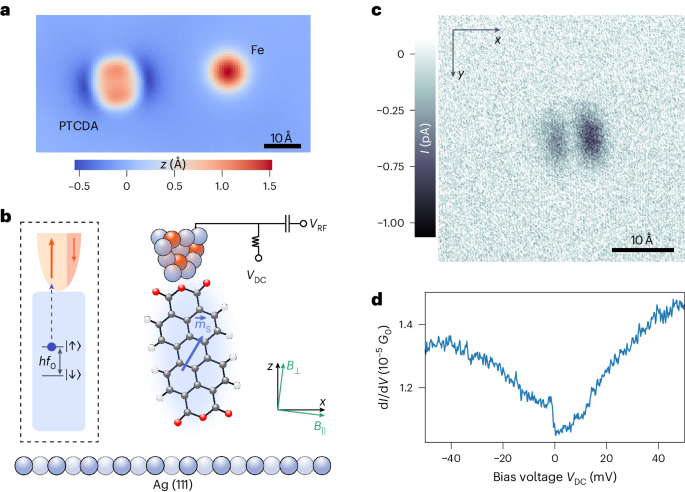A quantum sensor for atomic-scale electric and magnetic fields
IF 38.1
1区 材料科学
Q1 MATERIALS SCIENCE, MULTIDISCIPLINARY
引用次数: 0
Abstract
The detection of faint magnetic fields from single-electron and nuclear spins at the atomic scale is a long-standing challenge in physics. While current mobile quantum sensors achieve single-electron spin sensitivity, atomic spatial resolution remains elusive for existing techniques. Here we fabricate a single-molecule quantum sensor at the apex of the metallic tip of a scanning tunnelling microscope by attaching Fe atoms and a PTCDA (3,4,9,10-perylenetetracarboxylic-dianhydride) molecule to the tip apex. We address the molecular spin by electron spin resonance and achieve ~100 neV resolution in energy. In a proof-of-principle experiment, we measure the magnetic and electric dipole fields emanating from a single Fe atom and an Ag dimer on an Ag(111) surface with sub-angstrom spatial resolution. Our method enables atomic-scale quantum sensing experiments of electric and magnetic fields on conducting surfaces and may find applications in the sensing of spin-labelled biomolecules and of spin textures in quantum materials. The fabrication of a molecular quantum sensor on the tip of a scanning tunnelling microscope enables the detection of minute magnetic and electric fields of single atoms with sub-angstrom resolution.


原子尺度电场和磁场的量子传感器。
在原子尺度上探测单电子自旋和核自旋产生的微弱磁场是物理学界长期面临的挑战。虽然目前的移动量子传感器实现了单电子自旋灵敏度,但原子空间分辨率仍然是现有技术难以实现的。在这里,我们通过将铁原子和 PTCDA(3,4,9,10-苝四羧酸二酐)分子附着在扫描隧穿显微镜金属尖端的顶点,制造出了单分子量子传感器。我们通过电子自旋共振来解决分子自旋问题,并实现了 ~100 neV 的能量分辨率。在原理验证实验中,我们以亚埃级的空间分辨率测量了 Ag(111) 表面上单个铁原子和 Ag 二聚体发出的磁场和电偶极子场。我们的方法实现了导电表面电场和磁场的原子尺度量子传感实验,可应用于自旋标记生物分子的传感和量子材料的自旋纹理。
本文章由计算机程序翻译,如有差异,请以英文原文为准。
求助全文
约1分钟内获得全文
求助全文
来源期刊

Nature nanotechnology
工程技术-材料科学:综合
CiteScore
59.70
自引率
0.80%
发文量
196
审稿时长
4-8 weeks
期刊介绍:
Nature Nanotechnology is a prestigious journal that publishes high-quality papers in various areas of nanoscience and nanotechnology. The journal focuses on the design, characterization, and production of structures, devices, and systems that manipulate and control materials at atomic, molecular, and macromolecular scales. It encompasses both bottom-up and top-down approaches, as well as their combinations.
Furthermore, Nature Nanotechnology fosters the exchange of ideas among researchers from diverse disciplines such as chemistry, physics, material science, biomedical research, engineering, and more. It promotes collaboration at the forefront of this multidisciplinary field. The journal covers a wide range of topics, from fundamental research in physics, chemistry, and biology, including computational work and simulations, to the development of innovative devices and technologies for various industrial sectors such as information technology, medicine, manufacturing, high-performance materials, energy, and environmental technologies. It includes coverage of organic, inorganic, and hybrid materials.
 求助内容:
求助内容: 应助结果提醒方式:
应助结果提醒方式:


